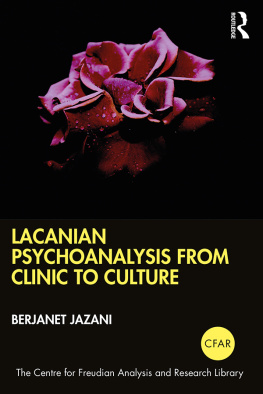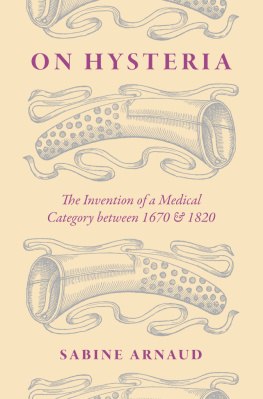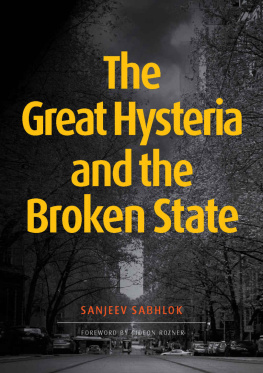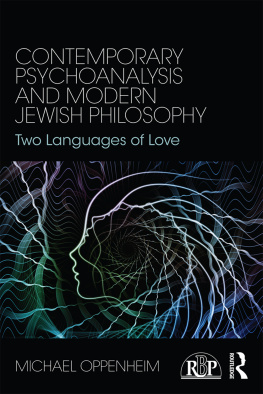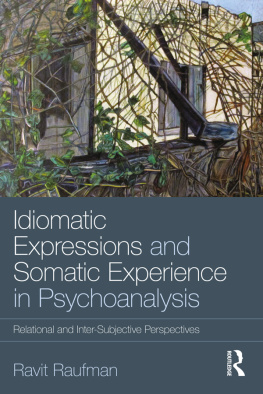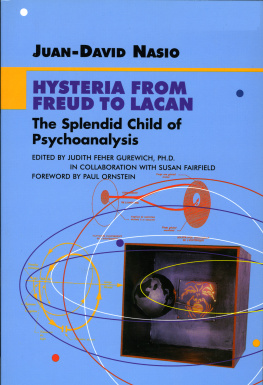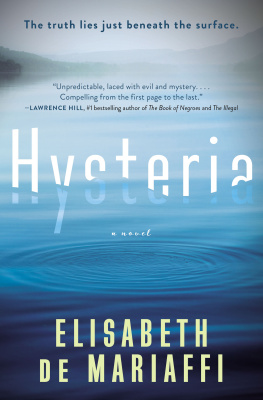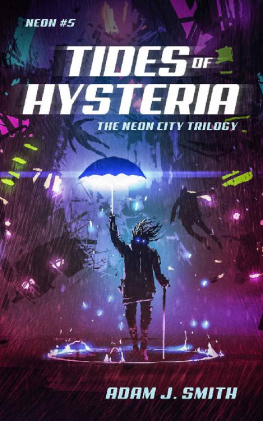Luckhurst Nicola - Studies in Hysteria
Here you can read online Luckhurst Nicola - Studies in Hysteria full text of the book (entire story) in english for free. Download pdf and epub, get meaning, cover and reviews about this ebook. City: London;New York, year: 2004, publisher: Penguin Group US, genre: Religion. Description of the work, (preface) as well as reviews are available. Best literature library LitArk.com created for fans of good reading and offers a wide selection of genres:
Romance novel
Science fiction
Adventure
Detective
Science
History
Home and family
Prose
Art
Politics
Computer
Non-fiction
Religion
Business
Children
Humor
Choose a favorite category and find really read worthwhile books. Enjoy immersion in the world of imagination, feel the emotions of the characters or learn something new for yourself, make an fascinating discovery.
- Book:Studies in Hysteria
- Author:
- Publisher:Penguin Group US
- Genre:
- Year:2004
- City:London;New York
- Rating:3 / 5
- Favourites:Add to favourites
- Your mark:
- 60
- 1
- 2
- 3
- 4
- 5
Studies in Hysteria: summary, description and annotation
We offer to read an annotation, description, summary or preface (depends on what the author of the book "Studies in Hysteria" wrote himself). If you haven't found the necessary information about the book — write in the comments, we will try to find it.
Studies in Hysteria — read online for free the complete book (whole text) full work
Below is the text of the book, divided by pages. System saving the place of the last page read, allows you to conveniently read the book "Studies in Hysteria" online for free, without having to search again every time where you left off. Put a bookmark, and you can go to the page where you finished reading at any time.
Font size:
Interval:
Bookmark:
PENGUIN  CLASSICS
CLASSICS
STUDIES IN HYSTERIA
SIGMUND FREUD was born in 1856 in Moravia; between the ages of four and eighty-two his home was in Vienna: in 1938 Hitlers invasion of Austria forced him to seek asylum in London, where he died in the following year. His career began with several years of brilliant work on the anatomy and physiology of the nervous system. He was almost thirty when, after a period of study under Charcot in Paris, his interests first turned to psychology; and after ten years of clinical work in Vienna (at first in collaboration with Josef Breuer, an older colleague) he invented what was to become psychoanalysis. This began simply as a method of treating neurotic patients through talking, but it quickly grew into an accumulation of knowledge about the workings of the mind in general. Freud was thus able to demonstrate the development of the sexual instinct in childhood and, largely on the basis of an examination of dreams, arrived at his fundamental discovery of the unconscious forces that influence our everyday thoughts and actions. Freuds life was uneventful, but his ideas shaped not only many specialist disciplines, but also the whole intellectual climate of the twentieth century.
NICOLA LUCKHURST is Lecturer in Literature at Goldsmiths College, University of London, and Distinguished Visiting Fellow at the European Humanities Research Centre, University of Oxford. Her publications include The Reception of Virginia Woolf in Europe, Science and Structure in Prousts A la recherche du temps perdu and Stphane Mallarm Correspondence.
RACHEL BOWLBYS books include Carried Away: The Invention of Modern Shopping (2000), Feminist Destinations and Further Essays on Virginia Woolf (1997), Shopping with Freud (1993) and Still Crazy After All These Years: Women, Writing and Psychoanalysis (1992). She is professor of English at the University of York.
ADAM PHILLIPS was formerly Principal Child Psychotherapist at Charing Cross Hospital in London. He is the author of Several books on psychoanalysis including On Kissing, Tickling and Being Bored, Darwins Worms, Promises, Promises and Houdinis Box.
SIGMUND FREUD
AND JOSEF BREUER
Studies in Hysteria
Translated by
NICOLA LUCKHURST
With an Introduction by
RACHEL BOWLBY
PENGUIN BOOKS
PENGUIN BOOKS
Published by the Penguin Group
Penguin Group (USA) Inc., 375 Hudson Street, New York, New York 10014, U.S.A.
Penguin Books Ltd, 80 Strand, London WC2R 0RL, England
Penguin Books Australia Ltd, 250 Camberwell Road, Camberwell, Victoria 3124, Australia
Penguin Books Canada Ltd, 10 Alcorn Avenue, Toronto, Ontario, Canada M4V 3B2
Penguin Books India (P) Ltd, 11 Community Centre, Panchsheel Park, New Delhi - 110 017, India
Penguin Group (NZ), cnr Airborne and Rosedale Roads, Albany, Auckland 1310, New Zealand
Penguin Books (South Africa) (Pty) Ltd, 24 Sturdee Avenue, Rosebank, Johannesburg 2196, South Africa
Penguin Books Ltd, Registered Offices:
80 Strand, London WC2R 0RL, England
ber den psychischen Mechanisms hysterischer Phnomene (Vorlufige Mitteilung)
first published in 1893 in Neurologisches Zentralblatt 12 (1) and (2)
Studien ber Hysterie first published 1895 (Leipzig and Vienna: Deuticke)
Hysterische Phantasien und ihre Beziehung zur Bisexualitt first published
1908 in Zeitschrift fr Sexualwissenschaft (1)
This translation first published in Penguin Books (U.K.) 2004
This translation published in Penguin Books (U.S.A.) 2004
7 9 10 8 6
Sigmund Freuds German texts collected in Gesammelte Werke (194052)
copyright Imago Publishing Co., Ltd., London, 1952
Translation and editorial matter copyright Nicola Luckhurst, 2004
Introduction copyright Rachel Bowlby, 2004
All rights reserved
LIBRARY OF CONGRESS CATALOGING IN PUBLICATION DATA
Freud, Sigmund, 18561939.
[Studien ber Hysteria. English]
Studies in hysteria / Sigmund Freud and Josef Breuer; translated by
Nicola Luckhurst; with an introduction by Rachel Bowlby.
p. cm.
Breuers name appears first on earlier editions.
Includes bibliographical references.
ISBN: 978-1-101-64481-2
1. Hysteria. 2. Psychoanalysis. I. Breuer, Josef, 18421925.
II. Luckhurst, Nicola III. Title.
RC532.F73813 2004
616.8524dc22 2004044287
Printed in the United States of America
Set in Adobe New Caledonia
Except in the United States of America, this book is sold subject to the condition that it shall not, by way of trade or otherwise, be lent, resold, hired out, or otherwise circulated without the publishers prior consent in any form of binding or cover other than that in which it is published and without a similar condition including this condition being imposed on the subsequent purchaser.
The scanning, uploading and distribution of this book via the Internet or via any other means without the permission of the publisher is illegal and punishable by law. Please purchase only authorized electronic editions, and do not participate in or encourage electronic piracy of copyrighted materials. Your support of the authors rights is appreciated.
Near the start of the Studies in Hysteria, Breuer and Freud describe what they have newly understood to be the sequence by which hysterical symptoms are cured:
The psychical process that had originally taken place has to be repeated in as vivid a way as possible, brought to its status nascendi, and then talked through. This makes any phenomena involving stimuli cramps, neuralgias, hallucinations appear once more at full intensity and then vanish [schwinden] forever. (p. )
The order outlined here involves a return to a point of origination; a repetition or re-reaction; and a final ending. Past, present and future interfere with one another and reconnect; a painful return of or to a past, resurrected and relived, makes possible a future forever free of the symptom. Hysterics suffer for the most part from reminiscences (p. ), in Breuer and Freuds resonant phrase; for their suffering to be relieved, the sore past must be allowed to emerge into the present, its pressure relieved.
What happens in this is dramatic. A performer makes a final appearance, a reprise for one last time, charged with the built-up emotion (at full intensity) of the finale. A rebirth (going back to the status nascendi) is followed by sudden death. This is a twofold drama, made up of the patients retrospective telling or reliving, now, during the therapeutic conversation, and the recovered history, now seen by the patient for what it was: for its subsequent significance. This recalls, or anticipates, what was to be the future role in psychoanalysis of an actual play: Sophocles Oedipus Rex. Oedipus story gives Freud the model of (male) childhood development in the structure of the Oedipus complex, but this is not all that the play suggests. Its action, as Freud points out in The Interpretation of Dreams (1900), consists of nothing other than dialogues that ultimately rewrite Oedipus history by showing it up in a completely different light: the combination of present conversation coupled with a reinterpretation of the past is exactly what happens in psychoanalysis.
The theatrical language of Breuer and Freuds exposition points to both a connection with and a departure from the treatment of hysteria at the time. In the mid-1880s, Freud had spent six months in Paris following the work of Charcot, the renowned psychiatrist who gave public presentations of hysterical patients at the Salptrire hospital. The patients were exhibited before an audience; their illness was seen in the form of a repeatable performance, in the four characteristic phases of a hysterical attack. Charcot used hypnosis to induce hysterical acts and attacks as a means of demonstrating their typical features. The effect was also to suggest that the illness, if it could be stimulated artificially in this way, was not primarily organic or hereditary. Breuer and Freud followed him in this theoretical postulate, but their treatment took a different course. The stress fell on the auditory not the visual; not on the patient as a bodily spectacle for assembled observers, but on her words to a single trusted interlocutor. Here the rehearsal of the symptoms is not didactic (for an audience) but therapeutic (for the patient). The theatre, as in the first quotation, is no longer a real one, in which symptoms are made to appear, but an analogical one in which they spontaneously perform for one last time.
Next pageFont size:
Interval:
Bookmark:
Similar books «Studies in Hysteria»
Look at similar books to Studies in Hysteria. We have selected literature similar in name and meaning in the hope of providing readers with more options to find new, interesting, not yet read works.
Discussion, reviews of the book Studies in Hysteria and just readers' own opinions. Leave your comments, write what you think about the work, its meaning or the main characters. Specify what exactly you liked and what you didn't like, and why you think so.


